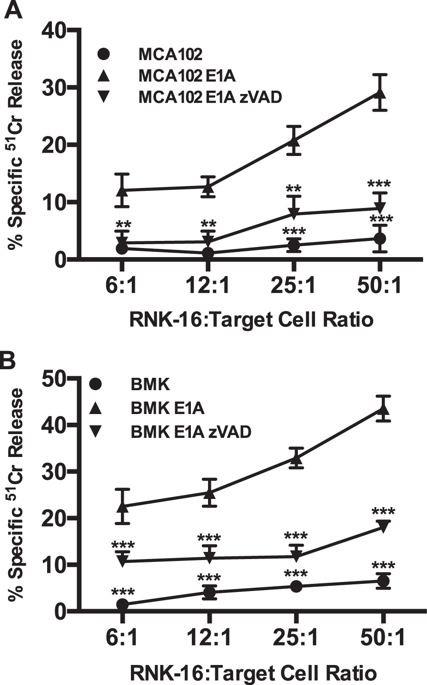当前位置:
X-MOL 学术
›
Cell Death Discov.
›
论文详情
Our official English website, www.x-mol.net, welcomes your
feedback! (Note: you will need to create a separate account there.)
E1A oncogene induced sensitization to NK cell induced apoptosis requires PIDD and Caspase-2.
Cell Death Discovery ( IF 6.1 ) Pub Date : 2019-07-01 , DOI: 10.1038/s41420-019-0189-z Jay R Radke 1 , John M Routes 2 , James L Cook 3, 4
Cell Death Discovery ( IF 6.1 ) Pub Date : 2019-07-01 , DOI: 10.1038/s41420-019-0189-z Jay R Radke 1 , John M Routes 2 , James L Cook 3, 4
Affiliation

|
Expression of the adenovirus E1A oncogene sensitizes tumor cells to innate immune rejection by NK cells. This increased NK sensitivity is only partly explained by an E1A-induced increase in target cell surface expression of NKG2D ligands. The post-recognition mechanisms by which E1A sensitizes cells to the apoptotic cell death response to NK injury remains to be defined. E1A sensitizes cells to apoptotic stimuli through two distinct mechanisms-repression of NF-κB-dependent antiapoptotic responses and enhancement of caspase-2 activation and related mitochondrial injury. The current studies examined the roles of each of these post-NKG2D-recognition pathways in the increased sensitivity of E1A-positive target cells to NK killing. Sensitization to NK-induced apoptosis was independent of E1A-mediated repression of cellular NF-κB responses but was dependent on the expression of both caspase-2 and the upstream, caspase-2 activating molecule, PIDD. Target cells lacking caspase-2 or PIDD expression retained E1A-induced increased expression of the NKG2D ligand, RAE-1. NK cell-induced mitochondrial injury of E1A-expressing cells did not require expression of the mitochondrial molecules, Bak or Bax. These results define a PIDD/caspase-2-dependent pathway, through which E1A sensitizes cells to NK-mediated cytolysis independently of and complementarily to E1A-enhanced NKG2D/RAE-1 ligand expression.
中文翻译:

E1A致癌基因诱导的对NK细胞诱导的凋亡的致敏作用需要PIDD和Caspase-2。
腺病毒E1A癌基因的表达使肿瘤细胞对NK细胞固有的免疫排斥反应敏感。NK敏感性的提高只能部分地由E1A诱导的NKG2D配体的靶细胞表面表达的增加来解释。E1A致敏细胞对NK损伤的凋亡细胞死亡应答的后识别机制仍有待确定。E1A通过两种不同的机制使细胞对凋亡刺激敏感:抑制NF-κB依赖性抗凋亡反应以及增强caspase-2活化和相关的线粒体损伤。当前的研究检查了这些后NKG2D识别通路中的每一个在E1A阳性靶细胞对NK杀伤的敏感性增加中的作用。对NK诱导的细胞凋亡的敏感性独立于E1A介导的细胞NF-κB反应抑制,但取决于caspase-2和上游caspase-2激活分子PIDD的表达。缺乏caspase-2或PIDD表达的靶细胞保留了E1A诱导的NKG2D配体RAE-1表达的增加。NK细胞诱导的表达E1A的细胞的线粒体损伤不需要线粒体分子Bak或Bax的表达。这些结果定义了一个PIDD / caspase-2依赖性途径,E1A通过该途径独立于E1A增强的NKG2D / RAE-1配体表达并使细胞对NK介导的细胞溶解敏感。缺乏caspase-2或PIDD表达的靶细胞保留了E1A诱导的NKG2D配体RAE-1表达的增加。NK细胞诱导的表达E1A的细胞的线粒体损伤不需要线粒体分子Bak或Bax的表达。这些结果定义了一个PIDD / caspase-2依赖性途径,E1A通过该途径独立于E1A增强的NKG2D / RAE-1配体表达并使细胞对NK介导的细胞溶解敏感。缺乏caspase-2或PIDD表达的靶细胞保留了E1A诱导的NKG2D配体RAE-1表达的增加。NK细胞诱导的表达E1A的细胞的线粒体损伤不需要线粒体分子Bak或Bax的表达。这些结果定义了一个PIDD / caspase-2依赖性途径,E1A通过该途径独立于E1A增强的NKG2D / RAE-1配体表达并使细胞对NK介导的细胞溶解敏感。
更新日期:2019-11-18
中文翻译:

E1A致癌基因诱导的对NK细胞诱导的凋亡的致敏作用需要PIDD和Caspase-2。
腺病毒E1A癌基因的表达使肿瘤细胞对NK细胞固有的免疫排斥反应敏感。NK敏感性的提高只能部分地由E1A诱导的NKG2D配体的靶细胞表面表达的增加来解释。E1A致敏细胞对NK损伤的凋亡细胞死亡应答的后识别机制仍有待确定。E1A通过两种不同的机制使细胞对凋亡刺激敏感:抑制NF-κB依赖性抗凋亡反应以及增强caspase-2活化和相关的线粒体损伤。当前的研究检查了这些后NKG2D识别通路中的每一个在E1A阳性靶细胞对NK杀伤的敏感性增加中的作用。对NK诱导的细胞凋亡的敏感性独立于E1A介导的细胞NF-κB反应抑制,但取决于caspase-2和上游caspase-2激活分子PIDD的表达。缺乏caspase-2或PIDD表达的靶细胞保留了E1A诱导的NKG2D配体RAE-1表达的增加。NK细胞诱导的表达E1A的细胞的线粒体损伤不需要线粒体分子Bak或Bax的表达。这些结果定义了一个PIDD / caspase-2依赖性途径,E1A通过该途径独立于E1A增强的NKG2D / RAE-1配体表达并使细胞对NK介导的细胞溶解敏感。缺乏caspase-2或PIDD表达的靶细胞保留了E1A诱导的NKG2D配体RAE-1表达的增加。NK细胞诱导的表达E1A的细胞的线粒体损伤不需要线粒体分子Bak或Bax的表达。这些结果定义了一个PIDD / caspase-2依赖性途径,E1A通过该途径独立于E1A增强的NKG2D / RAE-1配体表达并使细胞对NK介导的细胞溶解敏感。缺乏caspase-2或PIDD表达的靶细胞保留了E1A诱导的NKG2D配体RAE-1表达的增加。NK细胞诱导的表达E1A的细胞的线粒体损伤不需要线粒体分子Bak或Bax的表达。这些结果定义了一个PIDD / caspase-2依赖性途径,E1A通过该途径独立于E1A增强的NKG2D / RAE-1配体表达并使细胞对NK介导的细胞溶解敏感。











































 京公网安备 11010802027423号
京公网安备 11010802027423号